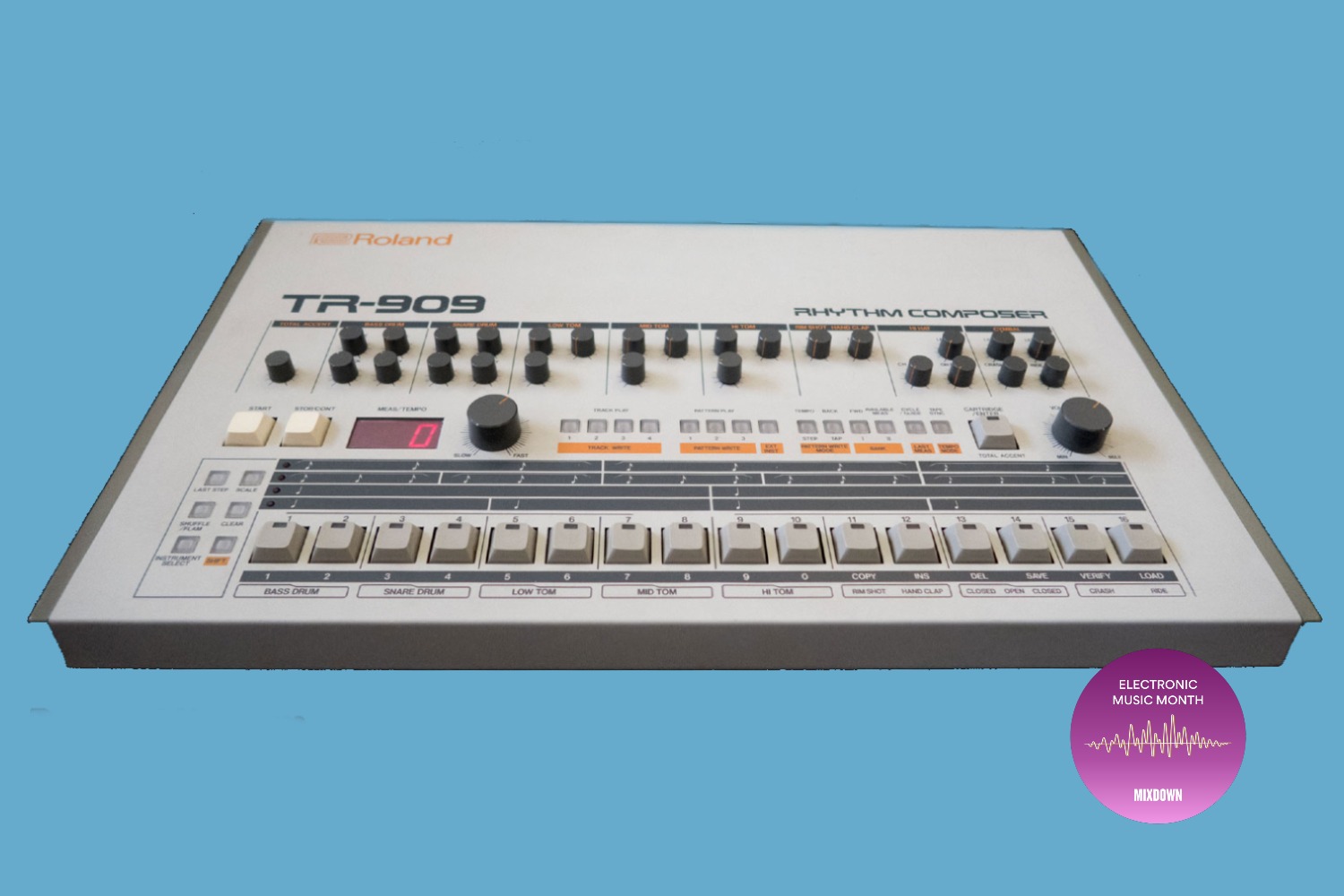Looking back at the legacy of Roland's iconic techno machine.
Introduced by Roland in 1983 as a successor to their then-maligned (yet similarly pivotal) TR-808 drum machine, the TR-909 proved to be even more of a commercial failure than its predecessor. At the time, musicians wanted drum machines to sound like real drums – the TR-909, on the other hand, was something totally unto itself.
A hybrid unit that fused PCM samples with analogue components, the 909 was far too punchy, gritty and unique to be used as a subsitute for real-sounding drums, and despite its powerful sequencing capabilities and MIDI connectivity, it just wasn’t what the people wanted, with sales suffering as a result.
Read all the latest features, columns and more here.
In order to cease their woes, Roland pulled the machine from production in 1984, and it’s rumoured that the company even dumped a batch of units in a huge landfill pile due to its financial flop – a move I’m sure they’ve second guessed every day since given the resale price of those early units.
As we know today, the Roland TR-909 picked up a second wind with the emergence of genres like house, acid and techno, with producers like Larry Heard and Jeff Mills using the drum machine to create pounding metallic dance tracks that subsequently wowed the world.
With the arrival of the ’90s, house and techno fever was in full swing, and the 909 – once considered a total failure by Roland – became the unlikely sound of the decade, enshrining its status as one of the most important drum machines of all time.
To celebrate the legacy of the fabled drum machine we’re diving into nine iconic tracks that utilise the TR-909, ranging from proto-industrial and avant garde through to the finest house and techno anthems.
Skinny Puppy – ‘Smothered’
Perhaps surprisingly, one of the earliest examples of the TR-909 on record actually comes in the form of an industrial track from Canadian trailblazers Skinny Puppy. ‘Smothered’ sees the group utilise the 909’s punchy kick drum and distinctive snare to forge a powerful backbeat for Nivek Ogre’s twisted vocal performance, and holds up as an intriguing debut for a machine that’s rarely associated with the industrial genre.
Mr. Fingers – ‘Can You Feel It’
Deemed to be one of the earliest deep house records ever, ‘Can You Feel It’ sees legendary Chicago producer Larry Heard, or Mr. Fingers, pair a Roland Juno 60 with a TR-909 to sublime effect. Despite the shoddy audio quality – the track was originally recorded to cassette in 1986 – ‘Can You Feel It’ still holds up today as one of the greatest dance tracks of all time, and it’s not uncommon to still hear it in night clubs on a regular basis.
Jeff Mills – ‘The Bells’
A techno classic through and through. Few producers work a TR-909 better than Jeff does, and ‘The Bells’ just acts as proof in the pudding. From the pounding four-to-the-floor kick to the subtle hi-hat manipulations that carry the song, ‘The Bells’ is an absolute masterstroke of techno production, and epitomises the unique timbre of the 909 better than anything.
Daft Punk – ‘Revolution 909’
One of the most memorable songs from Daft Punk’s 1997 debut Homework, ‘Revolution 909’ sees the French robots pay tribute to the titular 909 in the only way they know how to – with a red-hot scorcher of a dance floor track. Of course, that kick drum cuts through the mix like it’s nobody’s business, but it’s the heavily swung hi-hats and clever filtering that really make ‘Revolution 909’ the jam that it is.
Madonna – ‘Vogue’
Madonna’s 1990 hit ‘Vogue is one of the most notable instances of the TR-909 seeping into the mainstream, and it’s difficult to imagine the track without it. Listen closely, and you can hear the 909’s rolling snare and shuffled hi-hats working overtime to make ‘Vogue’ the dance floor smash that we know it to be, while that persistent kick drum just pounds away with a vengeance. This one’s nothing but a classic.
Björk – ‘Hunter’
One of the more unique examples of the TR-909 in a song that doesn’t fall under the house or techno hat, Icelandic goddess Björk utilises the snare of Roland’s techno machine in her track ‘Hunter’ to create an immense percussive loop to drive the sparse instrumental. It’s tracks like these that really showcase the distinctive tone of the 909: even when removed from the context of a techno track, this drum machine sticks out like a sore thumb.
Robin S. – ‘Show Me Love’
‘Show Me Love’ is often credited as being one of the tracks to bring house music to the mainstream, with the 1990 track being a prime example of the genre’s leap from nightclub to the charts. A Korg M1 organ supplies that famous bass groove, while a punchy Roland TR-909 pumps away in the background, making for a barebones house slammer that still holds up as one of the most irresistible dance tracks of all time.
Aphex Twin – ‘Heliosphan’
We all know that Richard D. James is a nut for Roland gear – his opener for Selected Ambient Works 85-92 famously opens up with a booming 808, and his affection for the SH-101 can be heard across several tracks in his immense back catalogue. On ‘Heliosphan’, he programs a TR-909 to inflict a devastating breakbeat onto the otherwise ambient composition, dropping layers in and out of the mix with reckless abandon to create one of the most forward-thinking productions of the era.
Orbital – ‘Halcyon On and On’
Orbital are considered heroes of the UK’s early rave days, and have a huge collection of bangers under their belts to show for it. ‘Halcyon On and On’ is one of the duo’s most pretty and serene tracks, with the Hartnoll brothers using a reversed and chopped vocal sample to create a hypnotic loop for the Roland TR-909 to sit under. As the track goes on, the TR-909 ramps up the action, with the kick drum working in tandem with the choppy hi-hats to propel ‘Halcyon On and On’ into a whole new field of its own.
Revisit the legacy of the TR-808 in our retrospective feature tracing its use from 1980 to now.

